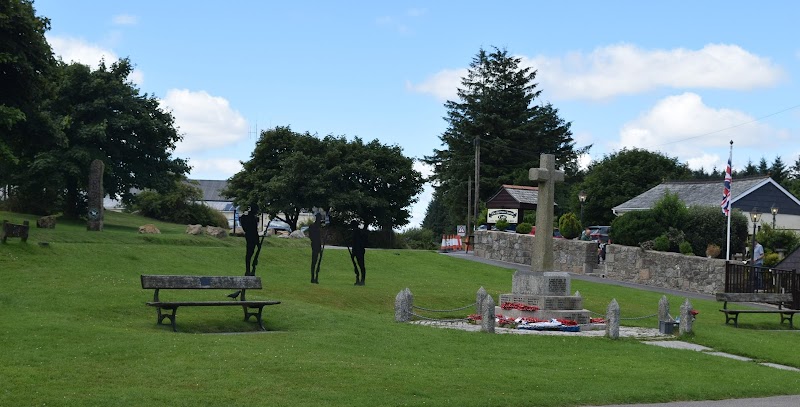Discover the Magic of Dartmoor National Park
Have you ever dreamed of embarking on a wild adventure in the largest and wildest expanse of open country in Southern England? The iconic Dartmoor National Park, covering an impressive 368 square miles, is the treasure you've been searching for. This park, laden with stunning granite tors, ancient woodlands, and intriguing Bronze Age settlements, is the perfect fusion of mesmerising beauty and historical richness. But the magic of Dartmoor extends beyond its natural wonders, it's a place that stirs the imagination and ignites a thirst for adventure.
A trustworthy tourist map of Dartmoor National Park, akin to a personal guide, reveals all the secrets this vast landscape holds. Navigating the rugged moors and the gently rolling hills has never been easier with this companion guiding you through the myriad paths. But this map offers more than just direction, it's a portal to an unforgettable journey into the heart of Dartmoor.
" Booking.comUncover the Hidden Gems of Dartmoor National Park
For the adventurous spirits yearning to delve into the untamed beauty of Dartmoor National Park, this is your perfect playground. Dartmoor's expansive landscapes, rugged beauty, and intriguing history offer a haven for tranquility seekers and adventurers alike. But the real thrill lies off the beaten paths where several hidden gems are waiting to be discovered.
Must-Visit Attractions in Dartmoor National Park
- Buckland Abbey
- Princetown National Park Visitor Center
- Lydford Gorge
- Merrivale Prehistoric Settlement
- Haytor Rocks
- Chagford
Experience the Historic Beauty of Buckland Abbey
Step back in time at Buckland Abbey, a historic gem dating back 700 years. Once the home of Sir Francis Drake, today the Abbey houses a museum filled with artifacts and exhibitions that recount the legendary tale of this sea captain. With a tourist map of United Kingdom, you can plan your journey to this historical marvel and enjoy a leisurely stroll in its stunning gardens and meadows.
Begin Your Dartmoor Adventure at Princetown National Park Visitor Center
Embark on your Dartmoor adventure from the Princetown National Park Visitor Center, located in the heart of Dartmoor. Here, you can learn about Dartmoor’s unique geology, wildlife, and history before setting off on one of the many walking trails. Take a short walk to the Dartmoor Prison Museum, where a fascinating glimpse into the life of inmates throughout history awaits.
Marvel at the Raw Beauty of Lydford Gorge
Experience nature at its most raw and beautiful at Lydford Gorge, the deepest gorge in the southwest. The enchanting White Lady Waterfall and the mysterious Devil's Cauldron whirlpools are a spectacle not to be missed. This haven of diverse flora and fauna is a paradise for nature enthusiasts.
Travel Back in Time at Merrivale Prehistoric Settlement
Get a glimpse into Dartmoor's ancient past at the Merrivale Prehistoric Settlement, one of the best-preserved Bronze Age sites in the United Kingdom. The standing stones, stone rows, and a stone circle provide a captivating insight into the lives of our ancestors and their relationship with the landscape.
Enjoy Breathtaking Views from Haytor Rocks
Haytor Rocks, standing tall above the moorland, are an iconic symbol of Dartmoor. These impressive granite formations offer exhilarating climbing opportunities and breathtaking views over the park. The nearby Haytor Granite Tramway and Quarries present a unique insight into Dartmoor’s industrial past.
Discover the Charm of Chagford
Unwind in the quaint market town of Chagford, a delightful blend of tradition and modernity. With its independent shops, artisan boutiques, and historic buildings, it's an ideal place to relax after a day of exploring. The vibrant arts scene and annual literary festival make Chagford a cultural hub within Dartmoor.

Practical Information for Dartmoor National Park
Transportation and Mobility
Reach Dartmoor National Park conveniently, thanks to multiple transportation options. The park is well-connected by road with the A30, A38 and A386 being the main routes. For those opting for public transport, both the bus and train networks serve areas near the park. For instance, Exeter and Plymouth, the nearest cities, have regular bus services to Dartmoor. The train stations of Newton Abbot, Totnes, and Exeter are all within a 30-minute drive of the park.
Schedules and Prices
Dartmoor National Park, open 24 hours a day, 365 days a year, offers free entrance. However, certain attractions within the park may have specific opening hours and fees. The High Moorland Visitor Centre in Princetown, for example, is typically open from 10 am to 3 pm during winter and from 10 am to 5 pm in the summer. Prices for organized tours and events vary, so it's advisable to check their official website for the most up-to-date information.
Safety Tips
Be prepared for the changeable Dartmoor weather by carrying appropriate clothing and footwear. Always have a map and compass as mobile service can be unreliable. Stick to marked trails when walking or cycling, and be aware of the risks of fast-flowing rivers and bogs. Remember, Dartmoor is a living, working landscape with farming and military activities, so respect all signs and keep a safe distance from livestock and wild animals.
Practical Recommendations
The best times to visit Dartmoor National Park are late spring, summer, and early autumn, when the weather is usually more favourable and the wildlife is most active. However, Dartmoor’s weather can be unpredictable, so pack layers and waterproof gear. Note that wild camping is only allowed in certain areas, so ensure you understand the regulations to preserve this beautiful environment for future generations.

Frequently Asked Questions about Dartmoor National Park
Are there any unique wildlife viewing opportunities at Dartmoor?
Indeed, Dartmoor is a haven for wildlife lovers. With over 450 miles of public rights of way, you can spot everything from otters in the rivers to skylarks in the heathland. For bird watchers, the park is home to a variety of rare and protected species, including the Dartford Warbler and Peregrine Falcon. However, it's important to maintain a respectful distance to avoid disturbing these fascinating creatures.
What kind of historical sites are there in Dartmoor?
Dartmoor is steeped in history and brimming with ancient sites. You can explore the renowned Grimspound Bronze Age settlement, a large circular enclosure with 24 stone huts. Or, visit the Hound Tor Medieval Village, a deserted settlement dating back to the 13th century. The stone circles, menhirs, and cairns scattered across the park further testify to its ancient past.
Can I do any water activities at Dartmoor?
Yes, Dartmoor caters to water sports enthusiasts. Try wild swimming in the stunning natural pools, or get your adrenaline pumping with some white-water kayaking on the River Dart. You can also enjoy a peaceful day of fly fishing. Just remember to respect the environment and follow safety guidelines while engaging in these thrilling activities.
Are there any walking or hiking trails suitable for families?
Dartmoor offers several family-friendly trails that are perfect for a leisurely walk or a picnic. The Fingle Bridge walk, featuring woodland paths and a historic bridge, is a popular choice. Another great option is the Burrator Reservoir circular walk, offering stunning views and easy paths. Remember to bring your map and stay on marked paths to ensure a safe and enjoyable experience.
What are the camping options in Dartmoor?
Dartmoor offers both wild and regular camping options. The park has a unique open-access policy, allowing wild camping in many of its areas. However, there are certain rules to follow, such as not camping within 100 metres of a road or a public path. There are also several organized campsites available throughout the park, offering amenities like toilet facilities and showers.
Can I bring my dog to Dartmoor?
Dartmoor is a fantastic place to bring your four-legged friend. Dogs are allowed in almost all areas of the park, but they must be kept under close control, especially during the lambing season and around wildlife. Always bag and bin your dog's waste to help keep the park clean and enjoyable for everyone.


